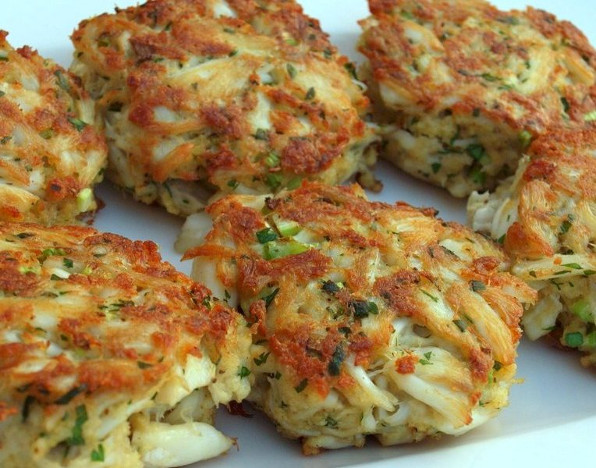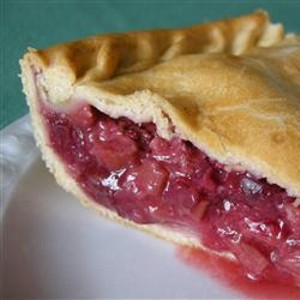Here’s a fun post for a sleepy Sunday in early summer. I’ve been researching foods whose names or common associations make them seem as though they’re something other than they really are, and the results are, to say the least, interesting. How may of these did you already know or suspect?
 Crab Cakes: One of the most popular uses for fate Crab Meat, or Surimi.
Crab Cakes: One of the most popular uses for fate Crab Meat, or Surimi.
Buffalo Wings? Tomatoes? Understudy Fish? Faux ‘foods’? You’ll probably be surprised by how many common foods are actually not what they seem. Most of these items are not clever industry ripoffs, and some you will already be aware of. But others ill surprise – maybe even shock – you…
Fruits or Veggies?
This whole research project was inspired by my recent post on Rhubarb. I was not too surprised to discover, while researching that one, that Rhubarb is not a fruit but a Veggie, in spite of the fact that we all consider it a member of the same broad family as Apples, Strawberries and other Dessert- or Preserve-destined goodies (see photo, top of page). It’s actually closer to Celery in the greater scheme of things. And just to complicate maters, the US FDA has officially lumped it in with the Fruits for the purpose of its arcane (some say unknowable) classification system.
On the flip side of this equation is the humble Tomato, which turns out be be a Fruit rather than a Veggie, by official scientific standards. Again, it’s commonly thought of as a Veggie because we use it in out cuisine as we would a Vegetable.
Peanuts are actually all ‘Pea’ and no ‘Nuts’. They’re close relatives of Chick Peas and Lentils. But, again, we consider them Nuts because they’re commonly used in the same ways as Nuts.
Fish and Seafood substitutions
Did you know that many Fish and Seafood products aren’t what they seem? And that the industry and the regulatory authorities that govern it are totally alright with that?
For example, the law says that many different species of Fish can be labelled ‘Sole‘.
The ‘Lobster‘ you get in different parts of the world can be any of a number of different crustaceans, depending on what it common in that region.
Red Snapper is almost always never real Red Snapper anymore. This one does fall into the category of fraud, not just nod-and-a-wink substitution. Red Snapper is a much prized Fish and has become rare. That means it’s really expensive when you do get the real thing. More likely, you’re paying a high price for some cheaper substitute.
Pollock, a fish which used to be used mainly in Cat Food and Fish Meal livestock feed, is now commonly used in ‘Fake Crab‘, or Surimi products.
Although it’s illegal in most developed parts of the world, that can of Tuna from the supermarket shelf may, in fact, contain Dolphin.
…And that’s just a sampling of the nefarious stuff that’s going on behind the scenes at the Fish counter. Recent surveys in Canada, the US and Europe reveal that up to half of all Fish sold at retail these days may be something other than what it says on the label.
‘Swedish’ Meatballs and ‘Caesar’ Salad
One particularly interesting specialty within the broader category of Food that Isn’t What It Seems is that of often iconic recipes that got their names in unusual ways.
Swedish Meatballs actually originated in Turkey.
Caesar Salad has nothing to do with ancient Rome. In fact, it was invented from what he had on hand one really busy New Year’s Eve by LA Chef Caesar Cardini, an Italian immigrant who settled on San Diego, CA.
Buffalo Wings are not harvested from rare winged Bisons but get their name from the fact that hey were invented in Buffalo, NY.
The Bloody Caesar – darling of every American cocktail lounge back in the day – is an undisputed cousin of the venerable American Bloody Mary, but it actually originated in Canada 50 years ago this year.
American Cheese is not really Cheese at all. Okay, I’ll admit it has some real Cheese in it, but it’s largely composed of added Milk Solids, Vegetable Oil and Colouring agents. So adulterated is this iconic ‘Cheesed’ that it must, by law, be labelled ‘Processed Cheese Product’ or something similar in virtually all regulated jurisdictions.
Soy Milk and Nut Milks aren’t really Milk, but processed Veggie protein products made to look and taste like real Milk. They are not nutritionally equal to real Milk and are not recommended for growing children those who have been told by their doctor to drink more Milk’.
Olive Oil fraud continues to run rampant through out that industry, with anything and everything inferior being labelled ‘Extra Virgin’ for sale to unsuspecting consumers outside the Mediterranean region where most of it is grown.
Sushi lovers will be dismayed to learn that the Wasabi they get on their order in most cases is not Wasabi at all, but a mixture of Horseradish, Colouring and Spices. The real deal is nothing like the harsh, burning substitute but most folks don’t know the difference because they haven’t actually had the real deal.
And the list goes on…
The foregoing is just a sampling of high-profile examples of foods that aren’t what they seem to be. If the name of a food or menu item sounds too fantastical or cute to be true, it probably isn’t what the name implies it is…
~ Maggie J.

